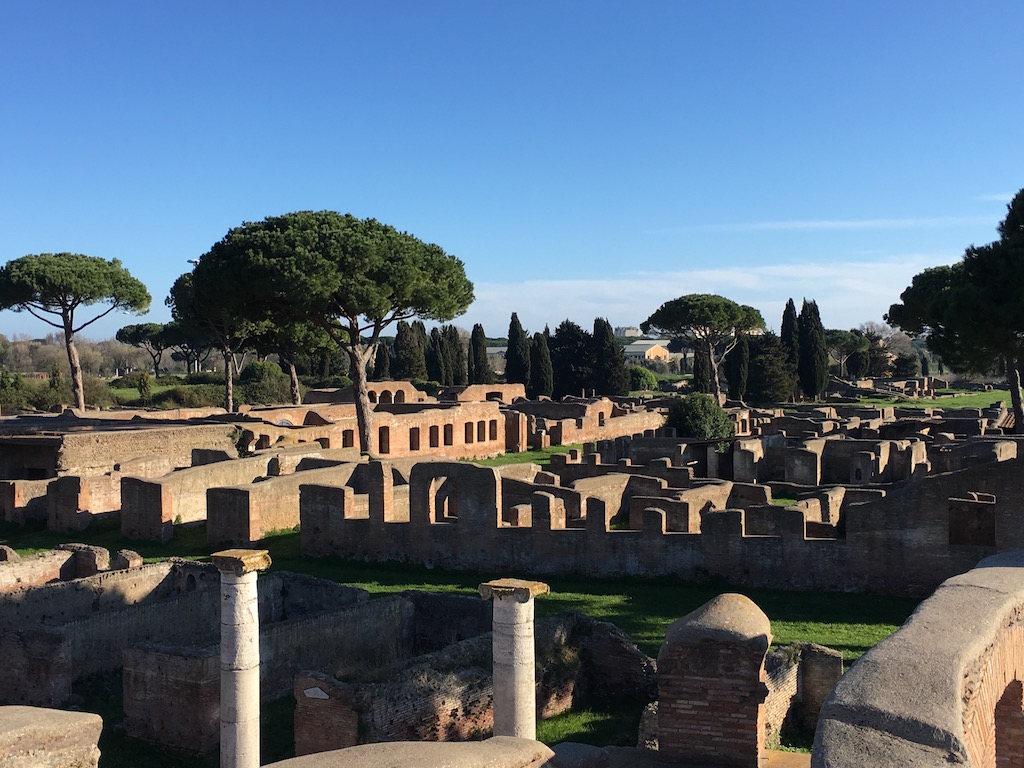1 Ostia Antica.
30 minutes out of Rome if you take the train going to the seaside you can step into an entire ancient city: you can stroll through its alleys, along its residential blocks, baths, firemen barracks, laundries, bars… it is the archeological site of Ostia Antica, the ancient harbor of Rome, with its 34h of surface one of the biggest sites in the world together with Pompeii but easier to reach from Rome, not to be missed if you really want to have a clear idea of what was living 2000 years ago!
2 Santa Maria degli Angeli.
Michelangelo is celebrated worldwide for his frescoes in the Sistine Chapel, the statues of “La Pietà” and the “David”, but he was also an architect. Santa Maria degli Angeli is the only church he created in Rome by exploiting the monumental warm rooms of an ancient Roman bath, a happy marriage between archeological and modern structures. Inside the church are buried the Italian heroes of World War I and there is the sundial that was used until 1846 to set the clocks at noon in Rome, before being substituted by the cannon shot from the Janiculum hill. Nowadays it is the church used for the most solemn celebrations of the Italian State.
3 Museo Nazionale Romano a Palazzo Massimo.
If you like ancient art but not crowds Rome offers a number of rich museums where you can stay face to face with the greatest works of antiquity. At the Museo Nazionale Romano di Palazzo Massimo for example you can make a visit to the big bronze of Boxer Mys who, after a career of never ending failures, won his first fight at 40, a great example of the chances that life gives to everybody who keeps on trying. The ticket to Palazzo Massimo is valid 4 days and grants the access to other 3 museums, that’s a great deal too!
4 EUR district.
EUR is the acronyme for the Italian Esposizione Universale di Roma, the universal exhibition that had to take place in Rome in 1942 for whom an entire new district was planned and built under the fascist regime. The war canceled the exhibition and stopped the works, which were completed after it. Recently chosen as one of the settings for the 007 movie “Spectre”, the district is totally built in white travertine, a unique example in Europe of rationalist architecture with its gorgeous perspectives, colonnades, mosaics that culminate in the magnificent view of the so-called squared Colosseum, now house of Fendi fashion brand. The area is a gorgeous setting for memorable photo shoot.
5 Orto botanico.
The botanical garden of Rome is a sort of unreal corner of Paradise on one side of the Janiculum hill from where you can get a glimpse of Rome from the Pantheon up to the Pincio hill, hidden amid the trees and the bushes. Its origins are set back to the Middle Ages to cultivate medicinal plants while nowadays the botanical garden covers 12 hectares including centenary woods, a bamboo and a mediterranean forrest, medical gardens, a Japanese and a rose garden together with various gracious historical garden-houses: in one of them there is the bathtub of queen Christine of Sweden who lived on the slopes of the hill, now used to grow fat plants… no reference at all to her Majesty of course!
6 Egyptian obelisks of Rome.
How did the visitors do when g.p.s. and city-maps didn’t exist? It’s easy… they followed the obelisks! If you like walking you can try to explore the entire city in one day like a traveller from the past following the obelisks that where raised by the popes in the major squares to help the pilgrims moving. You can start in Piazza del Popolo, reach the Spanish Steps, move to Santa Maria Maggiore and St. John’s, touch the Colosseum and go back to the start, or deviate and end at St. Peter’s square. It’s a long long walk but finally the best way to walk the whole city center.
7 Santo Stefano Rotondo.
Not too far from the crowds of the Colosseum there is one of the most ancient churches of Rome, hidden in a paradisiac garden and unreal silence. Its perfect round shape and the bright light makes the visitor feel in a sort of fantasy medieval set Game-of-Thrones like. To give more excitement to the visit you can follow on the walls the paintings of Pomarancio showing the various creative ways used to kill the most famous martyrs of ancient times and then relax in the nearby Villa Celimontana garden under a centuries-old pine tree.
8 Non-catholic cemetery.
This was the ground given by the Roman Church to bury non Catholic people, when not being Catholic was not normal at all: here we find men and women of all religions and races resting together in peace under the protective bulk of the ancient Roman pyramid of Cestius and plants and flowers of any kind. The place counts an incredible number of writers, sculptors, historians and politicians and some great names like English poets J.Keats and his friend P.B.Shelley. It is easy to get in, while if you want to get out leave a tip for the automatic gate to open, the night can be long and scary…
9 Castel Sant’Angelo.
Close to St. Peter’s church there is the monumental tomb of the emperor Hadrian. In the Middle Ages it became the castle of the popes set by the river, used as a prison for the enemies and as a fortress in case of danger, accessible from a straight path from the papal palace. You can visit the jail where notable guest like the count of Cagliostro spent not a very good time, and the upper private rooms for the popes, to end on the spectacular top floor and share a 360° view of the city with the statue of the angel that according to the legend appeared to set the city free from an epidemic.
10 Villa Farnesina.
Villa Farnesina was a luxury residence by the Tiber river whose owner, banker Agostino Chigi used to give dinners with precious silverware thrown in the water at the end of the every party. Here painter Raphael worked on the splendid paintings always having at his side his lover and model Fornarina, claiming that otherwise he couldn’t concentrate and do anything at all. That spirit of life and Raphael’s masterpieces are still preserved, and the visit of Villa Farnesina will make you step back to a world made of true love, lavishness, joy and elegance.

Hi! I’m Alessia and I was born in the area of the Roman Castles, region of the legendary Romulus, big ponitfical villas and good wine.
It is perhaps for this reason that growing up I have developed a great love for archaeology that represents my cultural background, completed with studies in Art History that allowed me getting my license as official tour guide of Rome and Vatican city in 2010.
I’m also a wine taster in AIS (Italian Association of Sommeliers) and a gourmand, but after all I
Continue reading
Contact Alessia Aquilanti



